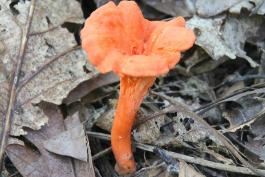
Small, reddish orange, vase-shaped; forked ridges on the underside descending the stalk. Grows in the soil. Late June to early August. Cap convex, becoming flat, with incurved, wavy margins; reddish orange, becoming pinkish with age; texture smooth. Underside reddish to pinkish, with thick-edged ridges that are forked, cross-veined, and descend the stalk; does not have true gills. Stalk can be tapering downward and can be off-center; reddish orange; texture smooth. Spore print pinkish-cream. Spores magnified are elliptical, smooth.
Lookalikes: The scarlet cup (Sarcoscypha dudleyi) fruits on dead branches and twigs.
Cap width: ¼–1½ inches; stalk length: ½–1½ inches; stalk width: ¼–½ inch.

Statewide.
Habitat and Conservation
Grows singly or in groups of up to many in moss, leaves, and grass, on paths, and under oaks. This is a very common little mushroom and when it is present, it is often a sign that other chanterelles (C. cibarius, C. lateritius) are around.
Status
Considered a good edible. Although it doesn’t have a lot of flavor, the cinnabar chanterelle retains its attractive color when cooked.
Life Cycle
This species is mycorrhizal: It exists as a network of cells (mycelium) connected to tree roots, in a symbiotic relationship with the tree. (Many trees fare poorly without their fungal partners.) When ready to reproduce, the mycelium sends up the “mushroom” aboveground—this is the reproductive structure. Spores are produced in mushrooms and are released to begin new mycelia elsewhere. The mycelium of a mushroom can live for decades.
Human Connections
Humans have eaten mushrooms for thousands of years, in many cultures, for various purposes. Sometimes they are eaten for their nutritional and culinary value; sometimes they are considered medicinal. Even if you don't eat them, you can still enjoy their forms and colors.
Ecosystem Connections
This is one of the many fungus species that help nourish forest trees through a symbiotic connection with tree roots. The netlike fibers of the fungus multiply the roots' ability for absorbing water and nutrients. In return, the tree shares nutrients with the fungus.


Mushrooms are a lot like plants, but they lack chlorophyll and have to take nutrients from other materials. Mushrooms are neither plants nor animals. They are in a different kingdom — the fungi. Fungi include the familiar mushroom-forming species, plus the yeasts, molds, smuts, and rusts.
Always be cautious when eating edible mushrooms. Be absolutely sure of the ID, and only eat a small amount the first time you try it to avoid a reaction..





















